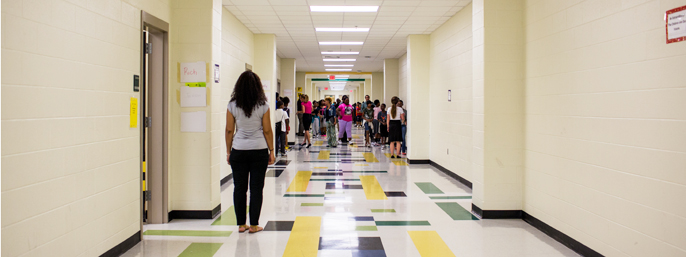Brian Ingram is a science teacher at Sherwood Middle School in Memphis, Tennessee, an iZone school two years into the turnaround process. As part of our continued series examining school turnaround, we spoke to Brian about what it’s like to be a teacher throughout the process.
Tell us about the first year of the turnaround process. Where did you start?
Year one was all about shifting the school climate and culture. Our principal realized part of the reason for the lack of success was the result of students (and teachers) not understanding what was expected of them. Prior to the turnaround process, students and teachers were not reaching their full potential, according to the data. So in year one, it just made sense to begin with the process of re-crafting the school’s mission and vision. We worked toward changing the mindset of not only students, but teachers as well. We set high expectations, made sure everyone took ownership of those expectations, and held each other accountable for achieving them.
How were those expectations set for faculty?
Our principal is very clear about what he expects from us: from our instructional plans to how we should conduct ourselves professionally, all the way down to what our classrooms should look like. He used a model classroom to clearly illustrate the kind of classrooms he wanted to foster before the school year even started. We taught 20-minute sample lessons with other teachers as students, and then we’d receive feedback from the principal and our colleagues. The model lessons showed us exactly what level of instruction was expected of us, and allowed us to practice and receive feedback before students ever entered our rooms.
How has the focus shifted in year two of the turnaround?
This year we’ve focused more on staff collaboration. Whereas last year everyone worked as islands, now, there is more of a family feeling among teachers in the school. We have organized more consistent schedules for our meetings and are coming together more regularly. We are much better about scheduling time to work in our departments, our teams, our grade levels, and as a whole staff. In my opinion, this new focus has been very beneficial—we can share best practices and learn from other teachers in the school. For instance, someone may be using a particularly successful tactic to engage students’ critical thinking in math and can share that tactic with teachers in both lower and higher grade levels.
How are you using data as part of the turnaround effort?
Every decision we make, long and short-term, is based on data. We all really care about making progress and meeting our potential. So we talk about data all the time and ask each other questions like: What are you doing in your class? Your kids are getting perfect scores on this strand and mine aren't—what is it that’s working for you? The data allows us to quickly identify the best practices in the building, as well as the deficiencies. When we do our “Do Now” at the start of class, I input my students’ responses into the system as they go along and it gives me immediate feedback on how many students understood the task. That helps me know whether I need to slow it down a bit or whether I can keep moving forward.
We are also a pilot school for the blended learning program. As part of that program, we were introduced to technology like Socrative. Using that, my kids can get immediate feedback on their learning and I can see right away what is working and what isn’t in my lessons.
What do you think next year will look like? How will you sustain the progress you've made?
We've already gotten word that there are two more local schools that are either going to be taken over or closed down. There's a possibility we could get an additional 200-400 students next year. So we're basically going to focus on the same things: keeping up our current students’ growth, but being prepared to adjust with a large number of new students and staff.
I'm not going to paint this process as a cake walk—there have been struggles and there will be more. But they’re productive struggles. Thus far, we've learned from all of our mistakes. So we'll be looking at this year and asking: What worked? What didn’t?
We have students here with severe academic challenges that are dealing with things at home and in their neighborhoods that I can’t even fathom. So I get very excited when I see them do as well as they're doing. Last year in the science department, our goal was 30 percent student proficiency on the state tests. Because a large majority of our students struggle with reading and vocabulary, I thought that would be hard to achieve. But through quality instruction and increased accountability for teachers and students, we were able to attain a 47 percent proficiency rate. Having the conversations about what we've done well or what we could do better is extremely important to continue that kind of success.
If you had to attribute your school’s progress to one thing, what would it be?
Consistency. It is very difficult to teach in chaos. If expectations are not set, and students and teachers aren't held accountable for doing their best work, it's hard for anyone to be productive. From day one of the turnaround process, our leadership team has been consistent in what they expect of us and our students—and they are clear about what is expected of them as well. We all hold each other accountable. In order to do that, we must be committed to the same goals.


